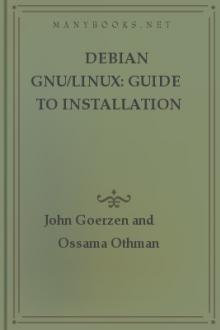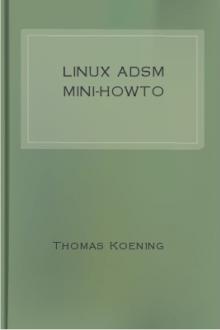Linux Accessibility HOWTO by Michael De La Rue (children's books read aloud .txt) 📕

-----
3.1.5.2. Braille Translation Software
The following Braille translation applications are available for download:
* Brass is a new program that combines speech and Braille output. The current version is still in testing and can be downloaded at: [http:// www.butenuth.onlinehome.de/blinux/] http://www.butenuth.onlinehome.de/ blinux/.
* BrLTTY supports parallel port and USB Braille displays and provides access to the Linux console. It drives the terminal and provides complete screen review capabilities. It is available at: [http://dave.mielke.cc/ brltty/] http://dave.mielke.cc/brltty/.
* NFBTrans is a freeware Braille translator written by the National Federation for the Blind (NFB). Software packages are available for download at: [http://www.nfb.org/nfbtrans.htm] http://www.nfb.org/ nfbtrans.htm.
-----
3.1.6. Cursors for X Windows
Chang
Read free book «Linux Accessibility HOWTO by Michael De La Rue (children's books read aloud .txt) 📕» - read online or download for free at americanlibrarybooks.com
- Author: Michael De La Rue
- Performer: -
Read book online «Linux Accessibility HOWTO by Michael De La Rue (children's books read aloud .txt) 📕». Author - Michael De La Rue
* The Trace Center provides information and downloads for various screen
readers and speech synthesizers. More information is available at: [http: //www.trace.wisc.edu/world/computer_access/unix/unixshar.html] http:// www.trace.wisc.edu/world/computer_access/unix/unixshar.html.6.1.2. Keyboard filters and Word Processing
Keyboard filters and word processing applications that have word prediction
and spell checking utilities can be an excellent aid for users with learning
and language impairments.
6.1.3. Speech Recognition
Speech recognition applications enables you to control the computer with your
voice rather than having to type or write out the information.
* CVoice Control is a speech recognition system that enables a user to
connect spoken commands to UNIX commands. More information is available at: [http://www.kiecza.de/daniel/linux/] http://www.kiecza.de/daniel/ linux/.* IBM ViaVoice Dictation for Linux allows the user to write documents using
their voice rather then a keyboard and can read the information back to the user. More information is available at: [http://www-4.ibm.com/ software/speech/dev/] http://www-4.ibm.com/software/speech/dev/.* Open Mind Speech is a development project for speech recognition tools
and applications. The developers have established a mailing list for asking questions and obtaining information at: [http:// freespeech.sourceforge.net/] http://freespeech.sourceforge.net/.* XVoice enables continuous speech to text dictation for many applications.
More information is available at: [http://www.compapp.dcu.ie/~tdoris/ Xvoice/] http://www.compapp.dcu.ie/~tdoris/Xvoice/. Developing Accessible ApplicationsIt is important to consider accessibility when developing new applications
for the Linux operating system. The American Foundation for the Blind, the
GNOME Accessibility Project, IBM, Sun, and W3C have written guidelines that
are excellent road maps for developing and testing new Linux software. The
following Web sites provide the tools, checklists and testing information to
help developers write accessible programs for impaired users.
* American Foundation for the Blind provides information on creating
accessible computer applications at: [http://www.afb.org/ info_document_view.asp?documentid=198] http://www.afb.org/ info_document_view.asp?documentid=198.* GNOME Accessibility Project has written a guide specifically for
application development for the GNOME 2.0 desktop. More information is available at: [http://developer.gnome.org/projects/gap/guide/gad/ index.html] http://developer.gnome.org/projects/gap/guide/gad/index.html.* IBM Accessibility Center provides links to a software accessibility
checklist, testing information, and the Section 508 Rehabilitation Act. This site is located at: [http://www-3.ibm.com/able/guidelines.html] http://www-3.ibm.com/able/guidelines.html.* Sun Accessibility provides information on designing applications for
accessibility at: [http://www.sun.com/access/developers/ software.guides.html] http://www.sun.com/access/developers/ software.guides.html and an Accessibility Quick Reference Guide is available at: [http://www.sun.com/access/developers/ access.quick.ref.html] http://www.sun.com/access/developers/ access.quick.ref.html.* W3C User Agent Accessibility Guidelines 1.0 provides guidelines on
accessible Web browser development including multimedia players and Web related software. [http://www.w3.org/TR/UAAGIO/] http://www.w3.org/TR/ UAAGIO/. Other Helpful InformationThe following is a list of additional information that may be helpful, but is
not necessarily targeting a specific disability:
* The CMU Sphinx Group Source has released a set of reasonably mature,
speech components that provide a basic level of technology to anyone interested in creating speech enabled applications. More information is available at: [http://fife.speech.cs.cmu.edu/sphinx/] http:// fife.speech.cs.cmu.edu/sphinx/.* Access to Linux documentation is critical to learning and using Linux.
The Linux Documentation Project has links to many Linux HOWTOs, mini HOWTOs, and guides, as well as information on becoming involved in authoring new HOWTOs. More information and downloads are available at: [http://www.linuxdoc.org] http://www.linuxdoc.org.* RPMFind.net provides rpm downloads for Linux applications on most Linux
operating systems. The site is located at:[http://www.rpmfind.net] http:/ /www.rpmfind.net.* Sourceforge provides updated information, documentation, and software for
Linux. Some of the applications available are under development. More information and downloads are available at: [http://www.sourceforge.net] http://www.sourceforge.net.* The Trace Center provides accessibility information and software for the
Linux operating system. More information is available at: [http:// trace.wisc.edu/worl/computer_access/] http://trace.wisc.edu/worl/ computer_access/ and the Linux Accessibility Resource Site (LARS) [http:/ /trace.wisc.edu/linux/] http://trace.wisc.edu/linux/.* W3C Web Accessibility initiative provides information and links on Web
site accessibility. More information is available at: [] . AcknowledgmentsThese are the orignal acknowledgments documented by Michael De La Rue. They
have been included in their entirety to ensure that each persons efforts to
make Linux more accessibile are acknowledged.
Much of this document was created from various information sources on the
Internet, many found from Yahoo and DEC's Alta Vista Search engine. Included
in this was the documentation of most of the software packages mentioned in
the text. Some information was also gleaned from the Royal National Institute
for the Blind's help sheets.
T.V. Raman, the author of Emacspeak has reliably contributed comments,
information and text as well as putting me in touch with other people who he
knew on the Internet.
Kenneth Albanowski [mailto:[email protected]] [email protected] provided the
patch needed for the Brailloterm and information about it.
Roland Dyroff of [http://www.suse.de/] S.u.S.E. GmbH (Linux distributors and
makers of S.u.S.E. Linux (English/German)) looked up KTS Stolper GmbH at my
request and got some hardware details and information on the Brailloterm.
The most major and careful checks over of this document were done by James
Bowden, [mailto:[email protected]] [email protected] and Nikhil Nair
[mailto:[email protected]] [email protected], the BRLTTY authors who
suggested a large number of corrections as well as extra information for some
topics.
The contributors to the blinux and linux-access mailing lists have
contributed to this document by providng information for me to read.
Mark E. Novak of the Trace R and D centre [http://trace.wisc.edu/] http://
trace.wisc.edu/ pointed me in the direction of several packages of software
and information which I had not seen before. He also made some comments on
the structure of the document which I have partially taken into account and
should probably do more about.
Other contributors include Nicolas Pitrie and Stephane Doyon.
A number of other people have contributed comments and information. Specific
contributions are acknowledged within the document.
This version was specifically produced for [http://www.redhat.com/]
RedHat's Dr. Linux book. This is because they provided warning of it's
impending release to myself and other LDP authors. Their doing this is
strongly appreciated since wrong or old information sits around much longer
in a book than on the Internet.
No doubt you made a contribution and I haven't mentioned it. Don't worry, it
was an accident. I'm sorry. Just tell me and I will add you to the next
version.





Comments (0)